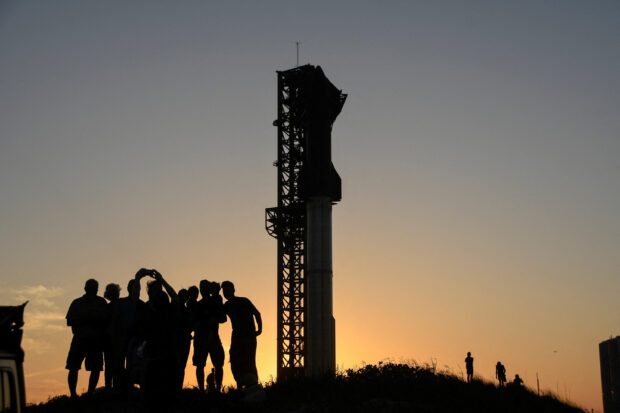SpaceX postpones debut flight of Starship rocket, citing frozen valve

FILE PHOTO: Tourists take photos at sunset of SpaceX’s Starship the day before it launches from the Starbase launchpad on an orbital test mission, in Boca Chica, Texas, US, April 16, 2023. REUTERS/Gene Blevins
BOCA CHICA, Texas — Elon Musk’s SpaceX called off the highly anticipated debut launch of its newly combined Starship cruise vessel and Super Heavy rocket in the final minutes of countdown due to a frozen valve, delaying the uncrewed test flight for at least two days.
The two-stage rocketship, standing taller than the Statue of Liberty at 394 feet (120 m) high, was originally slated for blast-off from the SpaceX “Starbase” facility at Boca Chica, Texas, during a two-hour launch window that began at 8 a.m. EDT (1200 GMT).
But the California-based company announced in a live webcast that it was scrubbing the planned 90-minute flight into space for a minimum of 48 hours, citing a frozen pressurization valve in the lower-stage rocket booster. That would make Wednesday the next available launch window for the mission.
SpaceX later said on Twitter that its teams were “working towards Thursday, April 20” for a second launch attempt.
The tweet set off a flurry of jokes on the social media platform making reference to 4/20 as a date widely associated with cannabis culture, and to the notoriety Musk gained in 2018 for smoking marijuana during an appearance on a live web show.
Musk, who purchased Twitter last year for $44 billion, is the founder, CEO and chief engineer of SpaceX. He also is chief executive of electric carmaker Tesla, Inc.
Getting the Starship to space for the first time would represent a key milestone in SpaceX’s ambition of sending humans back to the moon and ultimately to Mars – at least initially as part of NASA’s newly inaugurated human spaceflight program, Artemis.
A successful debut flight would also instantly rank the Starship system as the most powerful launch vehicle on Earth.
Both the lower-stage Super Heavy booster and the upper-stage Starship cruise vessel it would carry to space are designed as reusable components, capable of flying back to Earth for soft landings – a maneuver that has become routine for SpaceX’s smaller Falcon 9 rocket.
But neither stage would be recovered for the expendable first test flight to space. Instead, both parts of the spacecraft would end their inaugural flight with crash landings at sea – the upper-stage of the Starship coming down in the Pacific after achieving nearly one full orbit of the Earth.
Prototypes of the Starship cruise vessel have made five sub-space flights up to 6 miles (10 km) above Earth in recent years, but the Super Heavy booster has never left the ground.
In February, SpaceX did a test-firing of the booster, igniting 31 of its 33 Raptor engines for roughly 10 seconds with the rocket bolted in place vertically atop a platform.
The Federal Aviation Administration just last Friday granted a license for what would be the first test flight of the fully stacked rocket system, clearing a final regulatory hurdle for the long-awaited launch.
If all goes as planned for the next launch bid, all 33 Raptor engines will ignite simultaneously to loft the Starship on a flight most of the way around the Earth before it re-enters the atmosphere and free-falls into the Pacific at supersonic speed, about 60 miles (97 km) off the coast of the northern Hawaiian islands.
After separating from the Starship, the Super Heavy booster is expected to execute the beginnings of a controlled return flight before plunging into the Gulf of Mexico.
As designed, the Starship rocket is nearly two times more powerful than NASA’s own Space Launch System (SLS), which made its debut uncrewed flight to orbit in November, sending a NASA cruise vessel called Orion on a 10-day voyage around the moon and back.